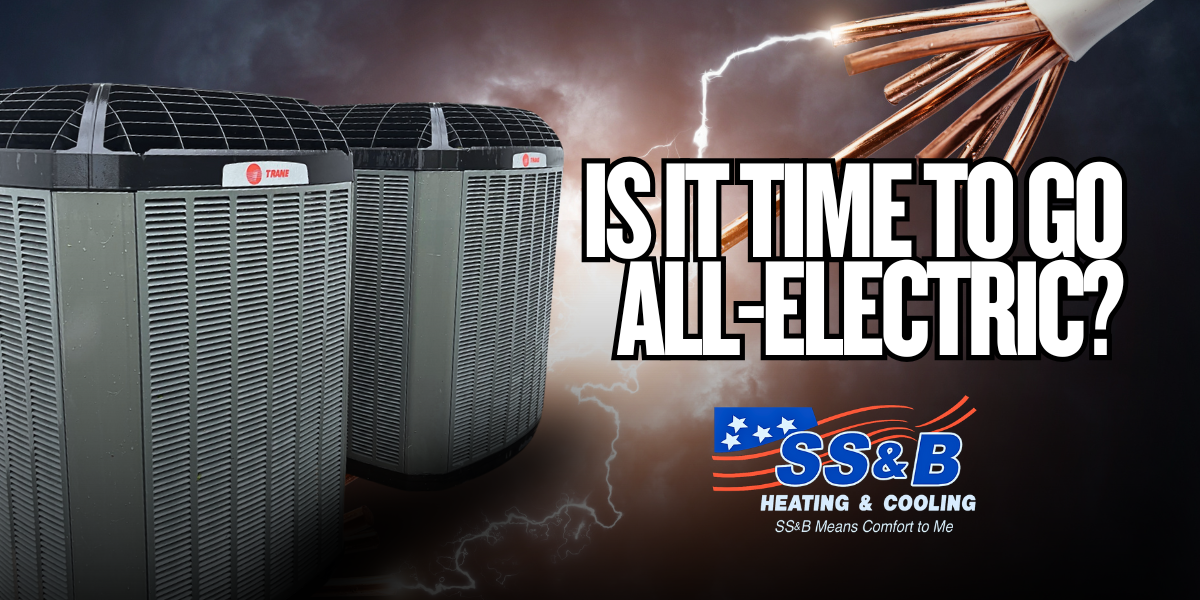At SS&B Heating & Cooling, we’ve noticed more homeowners asking about all-electric heating systems—specifically heat pumps—and how they stack up against traditional gas furnaces. This shift is part of a much larger movement across the country and even globally, called the Electrification of Heat.
But what does that actually mean for your home, your utility bills, and your comfort?
Let’s break it down in simple terms.
What is the Electrification of Heat?
In a nutshell, it’s the move away from fossil fuels like natural gas or propane and toward electric-powered heating—especially high-efficiency heat pump systems. The idea is to run homes on cleaner electricity, especially as the grid becomes more powered by renewables like wind and solar.
This doesn’t mean gas furnaces are going away overnight. But we are seeing a major push in HVAC and homebuilding to install electric heating systems that are both eco-friendly and reliable—even in colder climates like ours here in Missouri.
And for areas that do get bitterly cold in the winter, there’s a solution for that too: dual fuel or hybrid systems. These pair a heat pump with a gas furnace, letting your home heat mostly with electricity but automatically switch to gas when needed.
Why Are More Homeowners Going Electric?
We recently heard from Jason LeRoy, Director of Advanced Technology at Trane Residential, who summed it up well: “Electrification is one of the key technologies for reducing carbon emissions long-term. And the HVAC industry is right in the middle of it.”
It’s not just about the environment either—it’s also about comfort, efficiency, and cost over time. Here’s why more people are considering the switch:
Heat Pump Tech Isn’t New—It’s Just Better Now
Some folks still think heat pumps can’t handle the cold. That might’ve been true years ago, but today’s systems are a whole different story.
Trane has been engineering heat pumps since the 1970s, and the newest models—especially variable-speed, inverter-driven systems—are designed to maintain indoor comfort even when outdoor temps drop below freezing.
And Trane’s upcoming Cold Climate Heat Pump (CCHP) is in development right now. It was field-tested in Idaho and maintained comfort year-round while lowering energy use by 15% compared to a furnace.
Heat Pumps Replace Two Systems with One
A lot of customers are surprised to learn this: a heat pump isn’t just a heater. It also replaces your air conditioner. That means you’re getting one piece of equipment that handles both heating and cooling—no need to buy a separate furnace and AC.
While the upfront cost of a heat pump may be a bit higher than a standard air conditioner, you’re eliminating the need for two separate systems. Factor in rebates, energy savings, and potential federal tax credits, and it starts to make a lot of sense.
Built and Tested to Last
At SS&B, we only install systems we know will stand up to Missouri’s hot summers and cold winters. That’s why we stick with brands like Trane—because their products are tested beyond typical use conditions.
Trane’s SEET Lab (Systems Extreme Environmental Testing) simulates 5 years of wear and tear in just 16 weeks. Their heat pumps have proven to be some of the most reliable on the market.
What About Savings?
The savings you’ll see with a high-efficiency heat pump depend on where you live, how well your home is insulated, and your current energy rates. But in many homes, switching to a heat pump can lower overall utility bills—especially when paired with a smart thermostat.
High-efficiency systems use less electricity, and as more of our energy comes from cleaner sources, the environmental impact is lower too.
Are There Incentives?
Yes—and they can be significant. Homeowners may be eligible for:
- Federal tax credits (up to $2,000 for qualifying heat pumps)
- Local utility rebates from City Utilities of Springfield and others
- Financing options and labor protection warranties that help cover parts and refrigerant
We’re happy to help you figure out what applies to your home and budget.
What About When It’s Really Cold?
That’s where dual fuel systems shine. Many of our customers in Springfield and nearby towns opt for a hybrid setup: a high-efficiency heat pump for most of the year and a gas furnace that automatically kicks in when it gets below 20–22°F.
That’s actually what Jason LeRoy uses in his own home in Tyler, Texas. And while we get more cold days than Texas, our climate is still ideal for this kind of system.
Looking Ahead: Trane’s Commitment to Sustainability
Trane is pushing the envelope when it comes to energy-efficient HVAC. Their Gigaton Challenge aims to reduce one billion metric tons of greenhouse gas emissions by 2030. That’s not marketing fluff—that’s measurable action.
At SS&B, we align with that commitment. We’re not just here to sell equipment. We’re here to help our customers choose systems that make sense for their homes, their comfort, and their future.
Ready to See if a Heat Pump Makes Sense for You?
Whether you're building a new home or thinking about replacing an old furnace and AC, it’s worth taking a look at the options. We’ll walk you through the costs, compare systems, check for rebates, and explain how electrification could work for your home.
Let’s talk. SS&B Heating & Cooling has been serving Springfield, MO, and surrounding areas for over 50 years. Our experts are here to help you make the right decision for long-term comfort and efficiency.
Call us today for a free consultation! 417-866-0990, or you can conveniently contact us online. We're here to assist you!
Frequently Asked Questions
Which is the most efficient heating option: Heat Pump or Emergency Heat?

